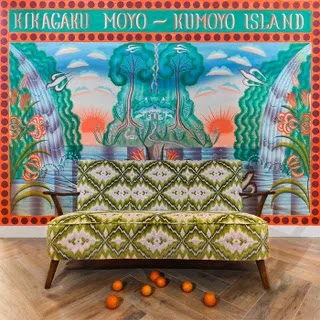On their final album, the Japanese psych rockers push beyond the horizons of their previous records. The songs are compact in comparison to their side-long odysseys, but they continually keep you guessing.
Kumoyo Island is a full-circle moment for Kikagaku Moyo, but the circle continues to widen. Earlier this year, the long-haired Japanese psych-rock unit announced an indefinite hiatus to follow the release of the LP, their fifth and final album. They’ve accomplished a lot in their decade as a band, earning fans worldwide thanks to sprawling, spellbinding live performances with two guitars and a sitar, and launching a label, Guruguru Brain, to document a growing crop of Asian psych acts. Returning to the studio in Tokyo where they recorded their earliest material, Kikagaku Moyo were given an unrestricted time limit, and the quintet used this opportunity to venture outside of its already expansive comfort zones. The result is a farewell album that feels like both a reinvention and a culmination.
Kikagaku Moyo began in 2012 as the duo of drummer/vocalist Go Kurosawa and guitarist/vocalist Tomo Katsurada. While spending time in the U.S. during college studies, they attended their first DIY house shows, which contrasted strikingly with venues in Japan charging musicians $300 to perform a 30-minute set. This inspired them to write lyrics in an imaginary language of invented syllables in the attempt to make their music universal, as they played early gigs busking under cherry-blossom trees and outside of train stations. Go’s brother Ryu was asked to join after he returned from India to study the sitar, while bassist Kotsuguy was invited when they found him recording the sound of vending machines for his drone project. This fusion of classical training and playful experimentation is partly what makes the band stand out from legions of stylistically constrained, retro-cosplaying psych acts.
Recent releases have included Kikagaku Moyo’s 2018 album Masana Temples—a relatively mellow collection of songs produced by Portuguese jazz guitarist Bruno Pernadas—and 2021’s Deep Fried Grandeur, a live collaboration with Ryley Walker. Kumoyo Island stands out from both with its busy instrumental arrangements and newfound embrace of Japanese cultural traditions. Taking its name from a wafer sweet, opener “Monaka” augments min'yō folk music with slinky electric guitars. “Yayoi Iyayoi” is a rare song from the band with lyrics in Japanese, beginning as a gentle lullaby before switching into minimalist garage rock. Midway through, it changes once again, adding chiming percussion and airy gang vocals before the riffs soar into the stratosphere. These songs are compact in comparison to the band’s side-long odysseys, but they consistently keep you guessing at what’s coming next.
“Dancing Blue” is one of the funkiest jams Kikagaku Moyo have laid to tape, layering a chicken-scratch wah-wah riff over handclaps and chanted vocals. Unlike other songs on the album, it maintains a consistent mood across its six minutes, making for a nice contrast with the more complexly structured patchworks. “Cardboard Pile,” on the other hand, fades in with a heavy, Boredoms-style groove that sounds like it’s already been building for several minutes, then abandons it completely. The song’s second half cycles through Tuareg-like guitar riffs and regal blasts of brass inspired by the funk music that Kikagaku Moyo encountered during their trip to Lisbon to record Masana Temples. The horns are a natural addition to the band’s wanderlusting sound, and could provide thrilling hip-hop sample fodder in the hands of an adventurous beatmaker.
“Meu Mar” continues to blur the boundaries between cultures. Originally written by Brazil’s Erasmos Carlos, the song’s Portuguese lyrics were first translated into English, then to Japanese. No matter what language the band sings in, “Gomugomu” is a psychedelic pop wonder, shifting between key changes as it bobs down a lazy river of warbling riffs and wailing guitar harmonies. Other short songs like “Daydream Soda” and “Field of Tiger Lilies” feel more like interludes than proper compositions, but they provide a welcome respite from the furious riffage. “Maison Silk Road” sails the album to a blissful ambient conclusion, with heavenly piano chords and curlicues of sitar that circle back to the sound of the band’s 2013 debut.
Kikagaku Moyo’s name translates to “Geometric Patterns.” This came to founding member Go Kurosawa during an all-night jam session when he was so tired that he began seeing grids of shapes when he closed his eyes. It sounds psychedelic, but it’s also something of a misnomer in terms of the band’s unstructured approach, which entails never taking more than two takes for any given song. “Even if someone makes a mistake, that’s the real us and mistakes can sometimes turn into really interesting peculiarities,” Kurosawa has said. As one of the most consistently thrilling representatives of a global psych community, Kikagaku Moyo continue to make unpredictable choices, even on an album that didn’t need to be more than a celebratory victory lap. Kumoyo Island is the apex of their journey, introducing new musical territories while surveying just how far they’ve traveled.



0 comments:
Post a Comment